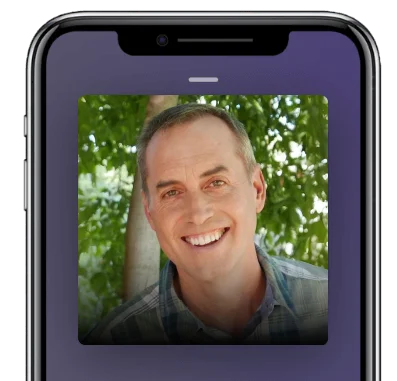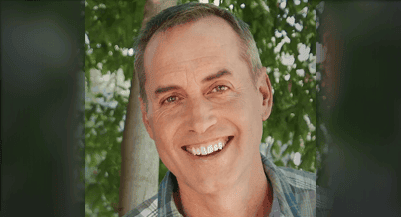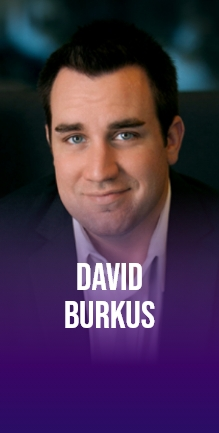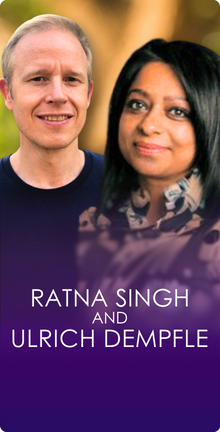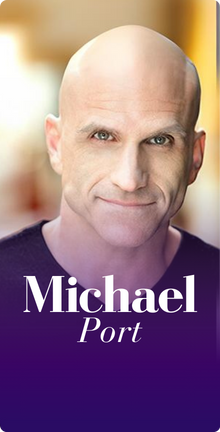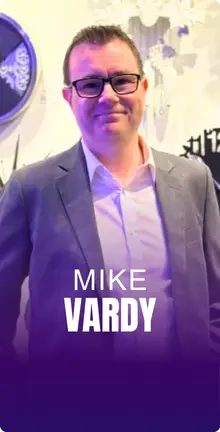Thanks for having me, Stephan.
First of all, I’m really excited that we’re doing a workshop together. We’ll talk more about that in the episode at some point. We were mutually introduced through a mutual friend. Do you want to say something about how that came about for you? I mean Genius Network, that’s how I know about our mutual friend.
Yeah. Genius Network. Part of that network is Michael Fishman who runs a community called Consumer Health Summit. In my Stanford Lab, we’re creating a go-to site about habits. It’ll be at habits.stanford.edu. I really wanted to do it in the right way, so I reached out to Michael, I was like, “Who’d he know who’s the world’s expert in X, Y, and Z?” and he introduced me to you. That’s how it happened. Through that network of Michael and Joe Polish who runs Genius Network, we crossed paths and I’m so glad about that.
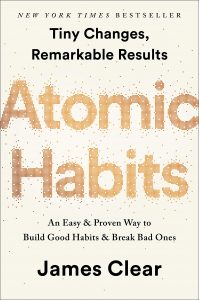
Me too. It’s been really fun working with you. I’m very excited about the workshop which we’ll talk about later. What’s amazing to me is that I was listening to the audiobook of—I hate to bring this name up—Atomic Habits by James Clear. Your name was mentioned in the book. It should have been mentioned a lot more because he was using so much of your research. I was really amazed to get connected with you after just hearing your name a few weeks earlier in the audiobook. Now, here we are in real life having a conversation.
On a podcast together, terrific.
The idea of not just interviewing you—you were on my wishlist of people to interview—but to collaborate together for me to help your lab with SEO, for you to work with me on a workshop that we do together at Stanford, just shows the power of proximity in an hour of your network.
Exactly, and now I’m on your speed dial on your phone. It is great where you just put it out in the world to either a community or a trusted person like, “Hey, I need help with this,” or “I need an introduction with somebody who’s really great at that,” and then rather than me just fumbling around on LinkedIn or something, you have a trusted friend or network connect us, which is great.
That’s a good opportunity for me to plug another episode of this podcast where I interviewed David Burkus. Do you know who David Burkus is?
Yeah.
He’s all about the power of the loose tie, the connection that isn’t a close friend and nurturing those because there’s so much power in them, so much value in those dormant ties, those dormant connections. Listeners, definitely check out the David Burkus episode.
Let’s talk about behavior. How did you end up diving so deep with the behavior that you became a world expert?
I’m going to reveal some stuff that I don’t usually reveal so brace yourself. It started when I was really young just learning to walk. I was raised in a Mormon household in California. Being raised as a Mormon, they train you very young to be a missionary, to preach Mormonism, and to convert people into that religion. This background in persuasion and behavior change came at an early stage. I’ve worked pretty carefully not to have that go online and not be associated with my bio and so on because I don’t want people to assume things about me that aren’t necessarily true. I’m no longer practicing Mormon and so on.
However, to answer your question honestly and thoroughly, that’s where it began. I did a two-year Mormon mission in Peru, which I loved, and I’ve never regretted doing that. I felt like I helped a lot of people. That’s all about behavior change. You’re getting people to stop smoking and stop drinking. If they’re living together and not married, you’re persuading them to get married. You’re getting people to be leaders in the congregation, as big as leading the entire congregation to directing the choir. All of this hands-on practice happened before I was 20.
As my interest shifted toward the power of language to influence people and rhetoric— I studied that in graduate school—finally, I became a social scientist. I was naive enough to not recognize I was shifting from the humanities, where you would approach rhetoric and persuasion in that way, to then becoming a social and behavioral scientist. Then studying it from different perspectives, different set of tools, and different set of theories.
A lot of powerful things can be applied for good or bad. My vision is to help people see how to use things in a good way, and help them stay ahead. Share on XMy interest at the beginning was about persuasion and technology. I did a whole bunch of research there, but in the last 10 years, it’s really become about human behavior in general and not about persuasion. It’s about helping people change their behavior in ways they want to change.
The thing about your life’s work is that it could be used for good or it could be for ill. There are people who are attention engineers, getting us sucked into apps like Facebook, social networks, and so forth. We’re squandering our valuable or precious time and attention doing stupid things when dopamine hits, and they’re basing that on your research.
That’s been put into books and blog posts and it’s been exaggerated. Actually, how much of my research actually formed that.
Tell me more about that.
Certainly. When Mark Zuckerberg started Facebook, he had never heard of me. Facebook grew quickly. When I saw Facebook in 2007, I met with them when they walked out of the meeting and it was like they’ve won the game. People don’t see it yet but they’ve got a checkmate. In 2007, I recognized that.
Did you invest all your money on them?
No. In fact, it was freaky for me to go. Oh, my gosh, and here’s one guy that owns more than half of it which means—let’s fast-forward here—what’s going to happen? He’s going to have this monopoly on how people communicate and understand each other, and it’s one person who controls it. Unfortunately, I was right in previewing that.
One of the things I did right away was as soon as they launched this thing that they called a platform—I think it was 2007—they invited me to be one of the partners on the platform along with about 40 other people and they all created these apps. That time, we wanted to call them widgets, but they said, “No, we’re calling them apps.”
So, I was there. This is some of the industry work I was doing. We were there at the launch and I saw how powerful some of those apps could be in reaching many people quickly in a way that’s never happened before. It wasn’t our app, but somebody else’s app reached a million people in a week which may not sound big by today’s standards, but at the time that was mind-blowing.
As soon as I saw that, I went to the computer science department where I was teaching and to the people that have seen my work and I said, “Hey, I want to teach a class on Facebook about Facebook apps,” and they said, “What?” Because it was back in the time when it was MySpace, Facebook, and other social networks. There were a lot of issues around child predators. The reputation was pretty bad and certainly wasn’t going to be taken seriously from an academic perspective. I said, “No, this thing has just happened where anybody can create an app or an experience, put it into an existing social network, and have it get adopted quickly.” I said, “This has never existed before and this is really important. I want to run a class on it because that’s my way of understanding something quickly.” We did and that led to what’s now the famous Facebook Class. As soon as that class was over, I decided not to talk about Facebook anymore. I saw the power of it.
Then my very next class, I called it Peace Technology. Let’s use the same power that we saw in Facebook, the ability to reach and influence others, and use it for the most ambitious thing which is world peace. Fast forward to today, that then led to a series of things. Today, the Peace Innovation Lab, its own lab at Stanford, they have headquarters in The Hague and they have affiliate labs around the world.
From my perspective, it wasn’t about Facebook. It was about understanding this power to influence people for better or influence people en masse. As soon as that was clear to me, “Wow, this is happening and going to happen. What do we apply it to? It was peace and then it was health. The working on the health then led me to my work now that I called Behavior Design, Tiny Habits, and so on.

Very cool. I love that evolution. You were just deconstructing what Facebook was doing and not trying to engineer how to take over the world or anything. You’re just like, “This is all about how insidious a platform can be if it’s not guided by powerful positive intentions to elevate our consciousness.”
Yeah, I think so. I’m a huge optimist. In fact, when I started my lab at Stanford 20 years ago, I put a sign up on the door that said, “Optimism is a strategy for making the world a better place.” That’s Noam Chomsky. I am an optimist. When I looked at it, it wasn’t about understanding what could go wrong with a platform like this; it’s basically owned by one person. It was, “Here’s this new thing that’s happening in the world, I want to understand it to apply this for good things.”
A lot of powerful things, as you said earlier, can be applied for good or bad. My view is to help people see how to use things in a good way, like to stay ahead. Play offense by helping people see the vision of how you can use things in good ways because the bad things will happen, but if you can give people the vision, inspire them to do good things in the world with these new capabilities, that was my game plan there.
Is that game plan panning out for you?
In some ways. It’s not like an experiment where I have a control group like, “Here’s BJ in a parallel universe.” That then opened the door for my work now that I call Behavior Design which is a fundamental rethinking of how human behavior works and how you help people specifically create habits that will make them happier and healthier. That work is a breakthrough. I don’t think it would have happened without the previous work in persuasive technology and really thinking systematically.
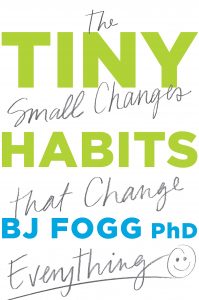
I love thinking about systems. These classes I was teaching at the time were all computer science classes. It’s systems kind of people. That helped me and encouraged me to think systematically about eventually how behavior works. It comes down to three components that are in my behavior model and also ways of designing for behavior change. That work is picking up more and more. It just delights me to see the positive impact it’s having in the world. With my upcoming book, Tiny Habits, where we’ll go next, I’m just thrilled about being able to share this with a broad global audience.
I’m excited too. It’s going to be world-changing. You’ve already had a profound impact on people and the planet directly and indirectly. You’ve had some really famous students who’ve made some significant impact in the world. Who would be some of the famous students that you’ve taught?
They may not be household names, but the things they’ve done have been. One of the students who was in one of my classes co-founded Instagram later. I believe the idea for Instagram, the idea of sharing photos in this simple way emerged from a class project. That’s Mike Krieger. One of my lab members went on to redesign Google Maps. Whenever anybody uses Google Maps, the design of that, the icons, and the way that things get visualized, all owe in part to his work. One of my students went on and created the autofill solution on Google. When you type in stuff, it fills in the rest of the word. At the time, that was very new. That was a student of mine, Jonathan. One of my students did a startup that LinkedIn acquired, so it’s now part of LinkedIn.
None of those names are probably household names but you’re using the products and services every day that maybe I influenced in some ways. Hopefully, I influence people for the better. I always talk about, “Hey, what I’ve taught you is powerful. Use it for good things. Use it to help individuals to be happier, households more harmonious, and communities more vibrant.” I really do talk about the importance of using what we’ve learned and the opportunities we have to make the world a better place. I know that sounds cliche and naive, but I’m an earnest person who believes we can make the world a better place. That’s what I’m all about.
I love that. Reveal light in the world is how I look at it. I learned that from Kabbalah. Some other people that I know have been students of yours that you might even have listed on your website, Ramit Sethi.
Yeah. Ramit? He’s doing awesome. His new version of his book is amazing. I give it to my entire family, like 40 people at a reunion. I gave it to all of my students at Cedar, and people have thanked me over and over. Even my dad who’s in his 80s called me—he’s done well financially—but he called me and said, “Oh, my gosh. This book is awesome. Everybody should read it.”
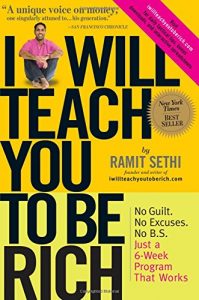
It’s a goofy title, don’t let them put you off. Ramit really knows his stuff. His work is very practical and this edition of the book even helped me. I’m a huge fan of what he’s doing and how he is really trying to help people have more financial security. More broadly, he defines a rich life more than just money but just helps people have better lives. Years ago, I was skeptical about what he was doing. He was my student and he started doing some of these things. Then after Stanford, Google offered him a job. I was like, “Oh, yeah, of course, you should take the Google job because get it on your resume,” and he didn’t do it. He went off and did his own thing which is probably the right answer.
Of course, he could compare himself in the parallel universe who did take the job. We can’t do that.
He made the right decision. It seems like at the time, how could working a year for Google be a mistake? But he went out and made tons of mistakes on his own. That’s how we learn to do better as you just go out there and do stuff. You just keep going. He’s certainly done so much research on how to effectively reach people and help them change their lives. I really admire what Ramit’s doing.
And he’s very approachable. He cares. I met him in 2014. He taught at a Secret Society. Neil Strauss has a secret society that’s not so secret. It has a website. Anyway, that’s how I got to meet Ramit and I was really impressed. I haven’t read the book. I think I will now.
Another student of yours who I think very highly of is Tristan Harris. He founded the Center for Humane Technology. He was part of the problem, in a way, but then he changed tracks and became part of the solution. He helped Google to suck us into the technology more and more and get more addicted to it. But then he was like, “Whoa, wait a second, this is not good for the human race.” He made a lot of money, and he was able to take that and create a non-profit to teach people to get unaddicted from their phones. I know there’s a trick that I used, that I learned from him, which is triple-click on your iPhone in the setting so that it goes to grayscale mode and you can’t use it in grayscale. When you need it in color, it’s just a triple-click away to get it back in color. That will get you using your phone less, keeping it in grayscale.
Yeah. I’m really proud of the work that Tristan has done. When he first was concerned about this—he was at Google—I don’t actually think, Stephan, that he worked on making Google products more compelling. Maybe we bring him in and ask him.
I want to have him on the show.
Making a difference is all about utilizing what you learned and the opportunities you have to make the world a better place. Share on XI think you should. His startup got acquired by Google. Then he was there and identified, really crystallized the responsibilities that people at Google had because they were influencing the lives of millions and billions and determining, in some ways, how they spend their most precious resource which is their time.
When he got clear on what he wanted to do—again this is me probably giving bad advice—he was talking to me and I was trying to help him understand how he could make a go of this, because he was not famous at the time and he’s like a voice in the wilderness, and I said, “You can write a book. You can do a conference. You can moonlight. Here are all the ways you can keep going with this. You had to stay at Google because you get a good paycheck and they’re supporting you.” So, he leaves Google—again didn’t follow my advice, which is great—and had a breakthrough with a TED talk.
That’s really where the change came from was his big TED talk. Now, he’s gotten so crystal clear on what the issues are and how to explain them. In fact, one of his recent podcast was so impressive, I sent it out to my entire family in email and said, “Hey, people, you gotta listen to this. This is what’s going on.” I’m a huge supporter of Tristan and he’s a support of me. Despite what some bloggers and journalists say, it’s not like Darth Vader-Luke Skywalker narrative, that’s what they put. That’s not true.
That’s what sells.
I know. That might be nice for them but it’s unfair to me. It’s really not helpful to the overall project of helping people have happier, healthier lives. To say somebody’s a black hat when they’re really a white hat. Tristan’s work developed in some great ways and he’s really raised visibility around this in ways that were just unimaginable, I would say 10 years ago when he was at Google and trying to start a conversation around this.
Definitely, you want to go check that out. Speaking of TED talks, do you have a TED talk?
Yeah. I have two TEDx talks. They’re fine. It’s such a great opportunity to speak at TEDx. It’s a very hard format. I love teaching and speaking and I say yes to all opportunities if I can. Then I got invited and given these TED talks. It’s 18 minutes, it’s very strict. It’s not really my style to memorize a talk, but the format forces you to. Hopefully, I’ll give more TED talks in the future. Probably, I won’t be as scripted as I felt I needed to be for the previous two because I don’t think I’m at my best when I’m trying to just remember something.
Yeah. You get to the point where it’s unconscious competence. You start with unconscious incompetence, then you move to conscious incompetence, then you go to conscious competence, and then the final level is unconscious competence. That’s where it’s so ingrained in you, it’s in your muscle memory and it gets you to another level. If you see somebody on stage who is just incredible at speaking, it’s almost certainly scripted and rehearsed to death. They could say their speech in their sleep. That’s why they get paid $50,000 for an hour-long talk.
I’ve gotten trained by one of the world’s best speaker-trainer Michael Port and his wife Amy Port. They’re both incredible. I went to their Heroic Public Speaking program. Actually, my wife and I both through it. We did HPS (Heroic Public Speaking) Live. We paid for VVIP so that we get on stage with them and get 45 minutes of private coaching in front of a group of 550 attendees live. It was incredible. We both did that and then we signed up for his graduate program where we had to fly across the country five different times—totally worth it—and stay for four days at a time to get this training that has definitely upped both of our speaking games. It’s incredible.
You can do it. You can totally have it so scripted and rehearsed. They have a whole seven-step rehearsal process. By the way, listeners, I did interview Michael Port. Check out that episode. It’s a great episode.
I have a different approach. It would drive me crazy to give the same talk over and over just like I don’t teach the same class at Stanford twice. That would just bore me. I always make up a new class. The talks, what I do, I try to understand what the organizer wants from the talk and what the audience needs and so on. I do a number of things, but just before I go out to give the talk, I look on the audience and I’m like, “What do they need that I know and how do I get it to them?” It’s really not about a script or anything, but it’s like, “I have some expertise, what part of my expertise is going to help them the most?” That works for me. I just speak what I know.
Back up a little bit, climate change is a huge problem and now that my book is done and it’s written, I have a little bit of extra bandwidth and I decided to create a program to train people that are working in climate action and behavior change in my work in Behavior Design. The first session happens today. It happens within the hour. After we get off here, Stephan, and I’ll set up a little bit more for that. It’s a series that we’re doing online, it will happen a number of weeks in a row. I don’t have a minute-by-minute script of what I’m teaching them in class today.
Usually, when I teach my work in-depth, it’s two days long. There’s no way I can teach for two days. I’ll go in. I know where I’m starting, but based on what they say in the feedback I get, then I will adjust so I can make the hour the most impactful hour for the people that are on the Zoom call with me.
I look at it in this situation, not so much a keynote where it’s like, “Okay, here’s what I’m covering, I may not say it in these words, but I know I’m talking about this,” but in this case, when I’m teaching at a small group, I know where I want to start, but then I guess it would be like playing at a coffee shop, like you’re playing the guitar, “Here’s a song I’m going to start with.” Based on the audience reaction and vibe, I’m going to do this one, and then this one, and this one. That’s what I do in my best teaching.
It’s like playing improvised jazz.
Yeah. It feels a lot like that. I don’t get nervous or afraid because I know my stuff, I know it deeply. It’s a matter of just ordering it and presenting it in the best possible way for these professionals working on climate action. Just super excited to do that and where this is headed is eventually a global curriculum that anybody who is working in the climate change arena, especially toward climate action can do. That way, I can bring my work into that domain and, hopefully, have an impact on where this is all going.
We all need to feel “shine.” It’s the emotion you feel whenever you do something and feel successful about it. Share on XWow, and boy do we need it. We’re at the precipice.
For me not to do that, I would just stay awake at night and feel terrible and awful. It’s just an obvious connection with my work. I just wish I would have done it a number of years ago.
I just had an interview with David Shenk. We were talking about climate change. It got so dark so fast and I was like, “We got to inject some hope into this.”
Optimism is a strategy. We have to believe that we can. At least, that’s the way I see it.
What’s the famous quote, “If you believe you can or you can’t, you’re right.” It’s Henry Ford who said that.
One of the things I’ll get across today for sure—people listening to this will find it interesting—is the best you can do, there are really two things for lasting change. One is to help people do what they already want to do. I call that Fogg maxim number one. It’s such an important concept that I branded it and it’s number one, help people do what they want to do. That means for these people working on climate action, if people don’t want to do the behavior, they’re not going to be able to persuade those people to do it. It’s really finding who wants to do what you’re getting them to do, whether it’s recycling, work from home, or whatever those behaviors are. Helping them understand the reality that you can’t persuade people to do things they don’t want to do in the long term, that does not work. What you can do is help people do what they already want to do. That’s the first maxim.
The next one is to help people feel successful. As they do that, how do you help them feel successful? If you miss either one of those two things, you will not get lasting engagement. You will not get long-term change. That will definitely come through today in the first hour with these folks and it will be—because I talked about this to a lot of industry people—very clarifying to them. It’s like, “Oh, my gosh. If they don’t want to use filtered water than water bottles, we’re just barking up the wrong tree. We need to find people that do want to and tell them how to.” It’s not about the why, it’s about the how-to. That’s how people have a fast impact. That’s how they can create successful products and programs.
Right, so if you really want your kids to eat their broccoli and they don’t want to eat their broccoli, you are beating your head against the wall.
You brought up a common but complicated behavior issue, Stephan. I’m not going to touch that.
Okay. Now I’m curious. When you do these two-day workshops, they’re not inexpensive. What does it cost to do a two-day workshop with you?
They are expensive. There are $4000. All of them sell out so I could raise the price, but we don’t want to raise the prices. They’re small, about 12 to 14 people come work with me for 2 days. I get to know every person and I understand what they’re working on. I customize the event for them. It’s expensive enough that it rules out some people. This is why the thing I’m doing with climate change, climate innovators, climate action folks is free. I’m going to scale and, hopefully, reach thousands of people in the right way.
Anything I do for education is free. Anything I do in the professional arena can be very expensive and I have nothing in between. I don’t do anything for a $500 honorarium. I just say, “Donate it somewhere.” The boot camps, they’re expensive, but I also said yes to giving a keynote in October for free because all of the proceeds go to an important nonprofit. I don’t know how you make decisions about who you charge in what and which things you do just for free just because it’s the right thing to do.
I go with my intuition.
Okay. That’s a good answer.
This might sound totally woo-woo to some of our listeners, probably many of them, but I had an Akashic records reading. I had not heard of Akashic records before earlier this year but a pretty well-known internet marketer who’s an expert in webinars told me he got an Akashic record reading, it was from this lady, and it was really helpful and gave him some insight. First, my wife, Orion, tried it. She’s like, “Wow, this is really good.” She couldn’t know these things about us and what’s happening. That was freaky and awesome. Then she got another Akashic records reading from the same lady. By then I’m like, “Okay, I’m in.” I had a really powerful reading.
We can all channel. We can all access the great Google and channel from our higher power, from ascended masters, or whatever your belief system is, you have this ability to channel. What I learned from this Akashic records reading, because I was curious about how do I develop that more, the answer that she channeled for me from my guides was to trust my intuition and just from an elevated place, a higher vibrational state, to share the thing and then to check it. This is the innovation that I didn’t know about is to ask the question, “Is this me or is this you?” then you will get the right answer. Isn’t that cool?
I like that.
If you say, “Alright, here’s this thing that is so inspired, it’s probably not even from me, I’m just channeling something,” and then you check it by saying, “Was this me or was this you?” Creator, higher power, God, or whatever you believe, and trust that answer.

Thank you for that. That strikes me in a number of ways. A lot of scientists are super skeptical and reject everything. The best scientist and the scientist I am or at least aspire to be is to stay open to possibilities. We may not be able to explain scientifically some of these things yet but you can’t just close the door and say, “Oh, that’s woo-woo or that’s impossible.” Staying open to possibilities that we can’t yet measure, test, or they just aren’t tractable with the scientific method is really important.
The other response is a little business but also personal. The stuff I’ve been able to discover or uncover, the behavior model, Tiny Habits, other models and methods in Behavior Design, was given to me. I have a responsibility to get it out into the world for people’s benefit. I really believe that, that it wasn’t just me working hard in my creativity genius that I created this thing. I uncovered these insights about human behavior that are breakthrough, new, and fresh, and I have a responsibility. I can’t not share it.
The hard thing for me is in prioritizing. How do I share this with who? When people apply to my Bootcamp, they get screened, and there are people that don’t get in it because they’re not working on things that are ultimately pro-social and will help the planet, or help people be happier and healthier, or when I’m deciding on my talks and so on.
With climate action, for example, they didn’t invite me like, “Hey, come teach climate action.” It’s just like, “This is a really important problem. I have one piece of the puzzle to contribute and this is what I can do so we’re going to do this.” Hopefully, it’ll go well and hopefully it will scale to the size that I hope but it is a sense of duty and responsibility because it was given to me. I don’t know how to describe it. You did a really good job of describing that sense.
Thank you. Another way of looking at things that have really helped me, especially when you talk about the thing about being skeptical, is this concept of the willing suspension of disbelief because then you’re open even if you are normally a skeptic. I used to think of myself as a skeptic but then I got this powerful distinction that probably isn’t even for me. I probably just channeled it, is that a skeptic and a cynic are two sides of the same coin. If you are a skeptic, you’re very close to being a cynic and nobody wants a cynic around them. That’s just an energy suck.
When you’re negative, you just attract more negative like, “Oh, I’m negative about my job, about the political environment,” or whatever. Well, guess what? It might be true and you are a magnet for negativity in all areas of your life because of that. I don’t want to be a cynic. I don’t even want to be a skeptic. I want to be positive. I want to be an optimist. I want to be revealing light everywhere. I want to have this willing suspension of disbelief and everything that I embark upon. That’s been very helpful for me and it could be helpful for our listeners, too.
Terrific. A couple of years ago, I made a new friend. I was warned in advance that this guy will complain about everything. They even had a nickname for him. I don’t want to say it in case he listens. But anyway, he’s going to complain about everything. I met him and yes, it was true like, “Oh, man, it’s an awesome weather,” and he’d say, “Yeah, but…” I turned it into a game after a couple of months of knowing him. Every time he said something negative, I would come back not in an abrasive confrontative way but I would come back with something positive. It took away in some ways the energy of his negative comments or the impact it had on me and it helped him be more positive.
What it helped me see as well was he really was fundamentally a very good guy but he just had to express this downside of things. By turning it into a game and just always having something positive to say in response to his negative thing, it actually became fun to be with him and I hung out with him a lot more, actually.
When you don’t try to change somebody’s behavior and you’re just a model of the good behavior, rather than trying to shove something down their throat around like, “Here, you need to do this,” or whatever, you’re much more effective in getting everybody else to change around you just by modeling the change we want to see in the world. That kind of paraphrase the Gandhi quote, right?
Let me build on that a little bit, Stephan. As you know, my book, Tiny Habits, that I finished writing comes out the first of the year. I’m super excited about it. One of the concepts—I have to fast forward two years from now—say what aspect of my book Tiny Habit is going to catch on the most or have the mix impact or both? It’s not what I thought it would be a year ago.
The book talks about Behavior Design, my behavior model, it goes in-depth in ways that I’ve never shared before and yes, it talks about Tiny Habits. It’s a really great way to create habits. But part of the Tiny Habits method is a way to help yourself feel successful. It’s a way to up-regulate a positive emotion of feeling successful. That technique is called celebration.
Let me fast-forward to the thing in the book that I think will maybe be the number one thing, say two years from now, once people have had a chance to read, is the emotion you have inside when you feel successful. It turns out there hasn’t been a name for that emotion and it’s really important because it wires habits and all these other things. In the book, I named the emotion and I call it shine. Shine is the emotion you feel when you do something and feel successful about it.
That’s awesome.
Whether you’ve ace a test, or whether you gave money to somebody who needed it, or whether you who said no to chips at the restaurant. Whatever it is, it’s that emotion that has this way of wiring habits into your brain. Then there are these other facts that you’re more positive on other things that come to you, you’re more positive with other people. I’ve shared this in some limited context with people on the thing that just strikes me so much is once we have this word for this feeling of success and once people understand how important it is, then they see, “Oh, my gosh, I need to help my kids feel shine. I need to help my students feel shine. I need to help my patients feel shine. Let’s design for shine.”
Practice doesn’t make perfect. Practice makes permanent. - Tony Robbins Share on XIn fact, at a very large healthcare company, I was training their leaders who are renovating their whole program, behavior change. I just said, “At the end of the day, you want to help people do what they want to do and smack someone and to help people feel successful, help people feel shine.” It snaps right into my second maxim and they got it. It’s like, “Everything you’re looking at, every idea, if it doesn’t help people feel successful, don’t do it.” Tracking behavior, does that help somebody feel successful? Yes or no? Some people it will. Some people, it won’t.
If they’re tracking their daily habits and they’re just seeing how many times they miss, that’s not a good technique for them because they’re not going to feel successful. That becomes, in some ways, a litmus test for any product program that you’re creating. Right here on the wall, I’m looking at a painting that my colleague, Stephanie, created for me that says “Strengthen.” She knows that my aspiration for this year and moving forward is to strengthen every person I interact with.
One of the ways I can strengthen them is by helping them see where they’re succeeding, not in a naive way, not in a makeup way, but just really helping them see. We had a big family here. My kids were painting. I’d go around and point out what I thought was especially good and just to really make that part of who I am. I am a person that helps other people feel successful. That helps them then change their behavior and the way they interact with others. I feel like I, as a single individual, in my everyday interactions, whether I’m checking out at the grocery store, getting out of an Uber, or looking at somebody’s painting at a family reunion, that’s how I think of the real and dramatic impact on people. That concept from the book, the idea of shine, the importance of feeling it, how you can help others feel shine, and how you benefit them so dramatically through that.
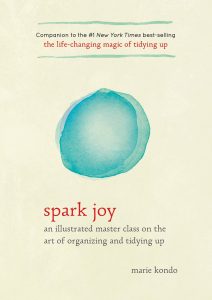
Wow, that’s a game-changer. That’s as important, probably even more so than Marie Kondo’s Spark Joy concept. If you pick up a book off your bookshelf and it’s like, “All right. Does this spark joy?” And you don’t even open it up and try to evaluate it, you’re just “uhm…” it, and look at the cover and touch it, and like, “All right. Does it spark joy? Yes or no? No, it doesn’t spark joy. I’m going to donate it.” Does it create shine? There’s this app that I was using for a while and it was helpful for a time but then I didn’t feel successful anymore. I didn’t feel shine, it’s called the Way of Life app, have you heard of it?
No, I haven’t.
You probably heard this before. Seinfeld, before his hit TV show, he would set himself up to always write a new joke every single day. The way he did that is he creates a chain. The chain would be Xs on the calendar. Each day that he wrote a new joke, he’d put an X in that day on the calendar. He didn’t want to break the chain because he’d have to mentally start all over again with a new chain. That kept him going. The app version of that is the Way of Life app. But it doesn’t always create shine because if I break the chain, which I do, like, “Okay, I’m going to do my morning connection every morning,” and then I miss it and then, “Oh, man, now I have to start all over again,” that doesn’t feel good. I don’t feel the shine. Then I stopped using the app. That’s powerful.
If you think about, “Does this create shine?” in everything that you do, this is very compatible with a concept I was just teaching one of my clients today. We had an hour-long call and I expressed to him that you need to add value with everything that you do. If you’re doing outreach to build links, if you are writing content, taking a 1000-word piece and turning it into 3000 words to increase its SEO value, are you adding value with that? Because if you’re not, why are you doing it? It’s just to game the algorithms? It’s just trying to exploit weird loopholes in the financial markets and some AI-based speed trading or something. You’re not adding value in the world. It’s spiritually bankrupt. He loved that concept. That was another thing he got out of that call. He loved it.
Good. Practicing that every day, trying to help others feel shine, keeping that on top of mind does help me do it but then there are challenging times as well. Going back to the family reunion, there’s a bunch of people here and they were here for 6 days, 35 people. That’s a lot. Then the kids ask these questions or they may even, at some point, I thought one of the kids was actually trying to annoy me. I just responded very short, just brushed her off. Then later I thought, “That’s not helping her feel shine.”
I do think even though I tapped into this and I know how powerful it can be, even in my own life, just really trying to be thoroughly or shall I say really consistent in doing that, there are going to be some challenging things like when people are rude to you. How do you help them feel shine? How do you strengthen somebody who has set out to actually tear you down or gaining at your expense? Those are some of the challenges I struggle with personally. That’s how I think about it.
I struggle with that. I feel good when I succeed. Even as simple as like I’m checking out of the grocery store and I noticed the person checking me out is faster than everybody else, I just go, “Man, you are the fastest person. This line goes the fastest of anybody.” Why not point that out? She probably goes home and shares it with the roommate like, “Hey, somebody said I was the fastest one here today.”
Yeah. If you’re just revealing light in the world and as part of your day, it doesn’t take you any extra time, you’re in line anyways, why not just get in that habit of revealing light?
I want to circle back to this whole Behavior Design thing. Why is it called Behavior Design?
Good question. About 2010 as my Stanford Lab, we were trying to help people create healthy habits and so on. We started using my behavior model and other things and we just realized this was a whole new way of thinking about behavior change and designing for behavior change so we thought, “Let’s give it a name.” We explored a bunch of things like behavior engineering and we settled on Behavior Design, that’s what we’re going to call this approach. I really do like that name. Other people are using it for other things, but at least, I use it and my lab members use it. It’s a set of models about how behavior works and it’s a set of methods of how are you designed for behaviors. That comprises Behavior Design.
You're much more effective in getting everybody else to change around you just by modeling the change we want to see in the world. Share on XI do think it’s a good label. I guess, my book, Tiny Habits, really is the first longer work where I explain, “This is Behavior Design. Here are the models, here are the methods, and so on.” Tiny Habits is one of the methods but that’s the title. The book’s really about Behavior Design for everyday people. What’s great about the models and methods is you can look at any behavior challenge. Then you can start with the challenge. You can break it down into what the behaviors are and then you can solve for the behavior.
Let’s take the climate action training I’ll be doing here in a little bit. I am not an expert on what behaviors need to change in order to basically save the planet. I’m not an expert of that, but I am an expert on how to think about behaviors and figure out how to change behaviors. What I’m doing in collaboration with the professionals is helping them identify and surface, “Here are the behaviors we need.” “Oh, we need politicians to do this. We need this company to do that. We need everyday people to do this. We need all the school systems to do that.” I can guide them and help by using Behavior Design and using those methods. I know I can walk them through the system so they can then surface and prioritize the best behaviors that will have the biggest impact. Then once they know what those behaviors are, they can then design for them. That’s what Behavior Design can do. Have you ever solved the Rubik’s Cube?
I actually cheated on that. I read a whole book on it. I was a kid and I wanted to show off and it worked. I was able to solve it really fast.
With Rubik’s Cube, what you find, at least the way I learned it as a kid, is you get the cube in a certain state and then from there, it’s just turnkey. “I do this, this, this. Boom. I’m done.” The Same thing with designing for behavior change. You can start it at any spot and then there’s a way you reduce it to specific behaviors and then you get it done.
That’s what it feels like. It’s a system. You’re not guessing in Behavior Design, it’s a systematic approach to any behavior challenges and then solve for it. That’s really fun because it does feel like a game. It does feel like solving Rubik’s Cube. You know you’re going to get it done, but you know every time is going to be a slightly different challenge. But you know there’s a finish line and you’ll get there.
But this is a fundamental rethinking on how to influence people and yourself.
Yeah. I will confess this. It is wiping the slate clean, the academic tradition and just starting over. I didn’t realize that’s what we were doing in 2008, 2009, and 2010, but as I look back, that’s how we did it. There are all these models, theories, and ideas about how to influence behavior and so on and they don’t work very well, so let’s instead figure out what does work.

You’re saying that these old systems that are out there, would you say that the idea of the cue, the habit, and the reward and changing the cue so it doesn’t trigger the habit, is that old-school thinking that you wipe the slate clean on or is that no, that’s basically how the brain works?
I would say it’s okay. That, as a model, was okay, analytical model. There’s a difference between analyzing and designing. You can analyze something and say, “Okay, here are the parts of it.” That’s different than being able to design it. When a certain author says, “If you understand the habit loop, you can change anything in your life.” I think that’s misleading people. You can’t.
It’s a false promise.
Yeah, it’s false. Yes, it’s a great marketing and it sells a lot of books, but it’s really unfair to tell people that because they believe you. Then when they can’t change a serious addiction or help somebody in their life to change, then they blame it on themselves. As a model, it’s okay, but it does not give you the specific steps of how to design solutions. That’s really what Behavior Design and Tiny Habits can do.
You said earlier there are three components?
Yeah. In my behavior model, it’s the fundamental model of how human behavior works. Behavior happens when three things come together at the same time. There’s motivation to do that behavior, there’s the ability to do the behavior, and there’s a prompt. There’s something that says, “Do this now.” When those three components converge, behavior happens, whether it’s a new behavior, whether it’s a habit. When you remove one of those components, the behavior won’t happen. That’s how you stop a behavior. You remove motivation, ability, or prompt. That model applies to all behaviors, all cultures, all ages. Where it differs is what motivates a person, that’s different by culture, age, and even by the time of day, their ability to do stuff, and also how you prompt them.
Metaphorically, it’s like the little tinker toy. That then you can bring a bunch of little tinker toys together and build something from. That’s the fundamental model that then you build other things from. The behavior model is an important breakthrough and important way of understanding how behavior works, and it was that model that helped me see my own model or model that came from a foreign behavior, as I said before, I felt like was given to me and I have a responsibility to share and steward into the world. Looking at that model helped me see the potential for creating habits in a new way. Which is now called the Tiny Habits Method. Essentially, it’s like you take whatever habit you want to form and you make it super easy.
You made yourself up to win.
Yeah. When I saw my model, it’s really easy to do, then you don’t need high levels of motivation. If something’s hard to do, like work out an hour a day, or meditate 30 minutes, or what have you, you need high levels of motivation to do that. As human beings, our motivation fluctuates over time. We don’t have a whole lot of control over it. We have some but we fluctuate. If you make it really easy to do, then you’re not susceptible to the swings in motivation. So then all you’re lacking is a prompt—this is one of my TED talks, is discovering this—and I discovered you can use an existing action you already do, a routine you already do in your life, to be the prompt for the new habit, like brushing becomes the prompt or the reminder for flossing. Oh my gosh. Amazing.
Sitting down on the train, on your commute home, which you do every day or some people do every day, can be the prompt for opening up a book and starting to read it. There you have it, the Tiny Habits Method account for motivation could you make it really easy to do ability and the prompt, you’ll find where it fits. What does it come after in your life? And to all those pieces are there.
The tooth brushing becomes the Trojan Horse that lets that new habit come in.
Yes. You leverage your existing habits and routines to become prompts for the new things you want in your life. That works really well. There are other ways to prompt yourself. I would post-it notes and alarms, and so on, but those become annoying or you become blind to them. The elegant way to prompt yourself is to find an existing routine you already have that can prompt something else. That’s a really good hack.
This is a profound, life-changing life hack, behavior hack that can change the whole course of your destiny, your business, your family, your friends, and your community, right?
Exactly because once you know how to create habits quickly and easily—that’s what the Tiny Habits Method is all about—you can form then quickly. Don’t believe in the 21-day thing. Form them very fast and it’s not hard to do. Then the question is, what habits do I want in my life? Then it comes back to wisdom and judgment.
Today I was practicing a new habit. I’ve tons and tons of new habits and I’m always goofing around with my behavior. But one of them that I want to do is to take a little bit of magnesium every night before I go to bed because it’s calming. What I discovered a little while ago in reading—it wasn’t my own research—is that for those of us who are super stressed out and that work hard and endure a lot of stress, we might be magnesium deficient and I’m pretty sure I was.
This morning I thought, “Okay, I’m going to get serious about making this a habit,” so I figured out exactly where it fits in my day, and then I rehearsed the habit. This is something I talk about in Tiny Habits and it’s going to strike them as crazy. I think in the future, that’ll just be obvious, but right now, that’ll be crazy. I decided where it fits in my day, is after my partner says, “Dinner is ready.” That then becomes my prompt to go and get the Magnesium, take the Magnesium right before dinner.
In the Tiny Habits Method, if you’re being a habit ninja, and being super awesome, you actually rehearse your habits in advance. Just like you people practice cutting, or people practice tennis serves, people practice three-pointers, you rehearse the habit and you include a celebration at then, you include the emotional piece. It’s going to sound crazy to do.
This morning I thought, “Yup I’m going to wire in this habit. I know where it fits or at least I know where it fits.” I sat on the couch, I imagined my partner saying, “Hey, dinner is ready,” and I was like, “Great.” I walked over to where the magnesium is and I said, “Good for me.” I celebrate, I fire it up for positive emotion. Then, when I went and sat back down on the couch again, I imagine him saying, “Hey, dinner is ready,” and I did it again, I did it seven times.
My dog thought I was crazy. She sees me like this before. The funny thing today was my dog was just watching me go back and forth. But what I was doing was I was rehearsing the behavior sequence and then I was wiring it into my brain by firing off the shine. And now, tonight, when my partner says, “Hey, dinner is ready.” Guess what’s going to happen. I’m going to get up, I’m going to say, “Thank you,” and I’m going to the right to where the magnesium is, and take the magnesium just before dinner. Because I’ve rehearsed it and I’ve wired it in. If it doesn’t happen, then I’ll rehearse some more.
That reminds me of a quote I learned from Tony Robbins. He said, “Practice doesn’t make perfect. Practice makes permanent.”
It does strike people. I’ve taught this in the Tiny Habit Certification Program and elsewhere where about rehearsing your new habit. Right after the prompt, do the habit, and then celebrate. Fire off the shine. Some people just think it’s so odd. In today’s world, yes it is odd, but when you understand that behavior changes a skill. Like other skills, you rehearse in order to wire it in, to make it second nature.
Stephen Curry, when he goes to take his three-point shot, isn’t deliberating, he isn’t thinking, he is not deciding. I guess I haven’t talked to him but he’s probably just acting automatically. He’s just wired in because he’s practiced it so much. That’s part of what I’m sharing in the book is, the way that you’ve heard about forming habits in the past isn’t limited and sometimes it’s downright wrong. Here are breakthroughs that you can put into practice right now, including this thing called rehearsal which you can think I’m crazy, but try it and see how fast you can wire in a new habit.
Awesome. We got to wrap up. But I want to give more detail to our listener about the workshop we’re doing together and what makes us so unique.
One of a kind. Never done before.
Right. We’re bringing together such different areas of expertise and life experience. It’s going to be really quite awesome. It’s really affordable. Stanford is charging normally $4000 for your two-day workshops and we’re going to do this for $1200 to this day-one workshop.
Yeah. There’s early bird pricing, and then there’s late bird pricing. Don’t be a late bird. This is unique, bringing together your air of expertise with mine at Stanford and having a whole day together. We share what we know and we help people apply it in a very practical way.
You’ve got some really good folks teaching it, and you’ll get to meet us personally, we’ll get to know you, and the surprise will be how cool the other people who are attending. In my style of teaching there’s lots of breaking into teams of three and four and do this, do this, and practice it so you really have the skill, you have it right in. You’ll get to know some really great people. I don’t think people are going to sign up for the networking, but that certainly will be part of the experience of being with us.
It’ll be part of the value-added. It’ll be a bonus. The workshop is called the Optimized Entrepreneur Behavior Change for Business Success. We are going to bring our best stuff and get you an outcome. You got to come. You just have to come on October 1st, full-day, and it’s at the Stanford Campus. It’s going to be really life-changing. It’s bitly.com/optimizedentrepreneur.
Yeah, so look in the show notes or it’s in my Twitter feed. Stephan’s probably in your Twitter feed. I’ll link to it. There’s something really Stanford about this, especially in the design school. What they want you to do is to create a learning experience where at least two people from different domains come together and look at the same problem or issue. That’s what we’re doing exactly here. How do you optimize yourself as a person or an entrepreneur, and that means both your professional life and your personal life. I know you’re really big on that, Stephan. It’s like, how do you do this life optimization and you’re going to give these two different approaches and we’re going to bring them together for the first time. I’m really excited about it.
Me too. Awesome. Thank you so much, BJ, for sharing so much of your back story, how the sausage is made, behavior change, how your book and the workshop came together, and how we’re out there trying to change the world. Now it’s time for you, the listener, to change the world. One of the first things you can do is sign up for our workshop to do that. Also when the book comes out, Tiny Habits, be sure to pick that up. Also, let me know what you’re doing in the world that’s out there revealing light. Send me an email, **@************er.com is the email address that will get directly to me and I will respond. Let me know that you’re listening and what you’re up to.
All right, we’ll catch you on the next episode and this is your host, Stephan Spencer, signing off.
Links and Resources
- BJ Fogg
- Tiny Habits
- Behavior Design
- Habits.stanford.edu
- Peace Technology
- Peace Innovation Lab
- Twitter – BJ Fogg
- Forget big change, start with a tiny habit
- Tiny surprises for happiness and health
- **@************er.com
- Atomic Habits by James Clear
- I Will Teach You to Be Rich
- Marie Kondo’s Spark Joy
- David Burkus – previous episode
- Michael Port – previous episode
- Genius Network
- Michael Fishman
- Consumer Health Summit
- Joe Polish
- David Burkus
- Mormonism
- Mark Zuckerberg
- MySpace
- Noam Chomsky
- Mike Krieger
- Google Maps
- Kabbalah
- Ramit Sethi
- Neil Strauss
- Tristan Harris
- Center for Humane Technology
- Tristan Harris – TED talk
- How better tech could protect us from distraction – Tristan Harris
- Michael Port
- Amy Port
- Heroic Public Speaking
- Zoom
- David Shenk
- Henry Ford
- Akashic records
- Gandhi
- Way of Life
- Jerry Seinfeld
- Rubik’s Cube
- Trojan Horse
- Tony Robbins
- Stephen Curry

